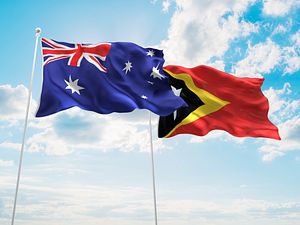This week will see a dispute between Australia and Timor-Leste over maritime boundaries begin in the Permanent Court of Arbitration in The Hague. At the center of the disputed territory lie the Greater Sunrise oil and gas fields. These fields are estimated to contain around US$40 billion worth of oil and gas deposits.
The conciliation proceedings fall under the UN Convention on the Law of the Sea (UNCLOS). This is a convention that Australia has signed, and Canberra has urged China adhere to UNCLOS with regard to Beijing’s claims in the South China Sea. However, Australia has a preference for bilateral negotiations for maritime boundaries, rather than international conventions. This is an acceptable practice within international law, but in this case remains a process between two vastly unequal partners.
Australia’s claim is based on its continental shelf extending into the Timor Sea, and not the conventional median line. The median line would place the Greater Sunrise fields within Timor-Leste’s maritime territory. Yet the dispute over the boundary is tied up in the complicated history of the region.
In 1972 Indonesia imprudently signed away rights to areas above the median line to Australia in the Australia–Indonesia Maritime Delimitation Treaty. However Portugal, then still the sovereign power over the eastern section of Timor, did not agree to the boundary assessment. This left a gap as to where the international boundary between Australia and the then-Portuguese Timor lay. Portugal believed that boundary should be based on the median line between Australia and its territory on Timor, in accordance with international conventions.
When Indonesia invaded Timor-Leste in late 1975, part of Australia’s acquiescence to the invasion was the hope that this gap in the maritime boundary would become consistent with the treaty of 1972.
In early 1978, Australia became the first Western government to recognize Timor-Leste as part of Indonesia, and a few months later the two countries began negotiations to settle the maritime boundary. Negotiations continued into the late-1980s, as Indonesia became unhappy with the 1972 treaty, and sought to make the median line the maritime boundary. These negotiations concluded with a treaty for Australia and Indonesia to share the proceeds of the Greater Sunrise deposits in a zone of cooperation.
However, this treaty became void in 2002 upon the creation of the new independent country of Timor-Leste, which gained the right to renegotiate the boundary as the new sovereign.
In 2006 negotiations between Australia and Timor-Leste created the Certain Maritime Arrangements in the Timor Sea (CMATS) treaty. Within this treaty Timor-Leste agreed to a clause that put a 50 year hold on negotiating a permanent maritime border, and to maintain the equal share of the revenues from the Greater Sunrise oil and gas deposits that was established between Australia and Indonesia.
The reason that the issue is now before the Permanent Court of Arbitration in The Hague is that Timor-Leste asserts that the CMATS treaty should be deemed invalid due to an Australian bugging operation on the Timor-Leste cabinet. In 2004, while pretending to be aid workers conducting renovations, Australian Secret Intelligence Service (ASIS) agents placed listening devices into the walls of a government office where the cabinet met. The information gathered from this operation gave the Australian government a significant upper hand in the negotiations that created the treaty.
Alongside this, Timor-Leste’s challenge to the treaty is also driven by economic concerns. According to the IMF’s calculations, Timor-Leste has a GDP per capita of just $5,628 at Purchasing Power Parity (PPP). It is an underdeveloped country, with 41 percent of its population below the poverty line, and only half of the country’s houses having electricity.
The country remains highly oil dependent, with present oil revenues providing approximately 95 percent of the state budget. While the country’s Petroleum Fund has been used responsibly in being directed toward essential capacity building blocks, halving the infant and child mortality rates, and making significant gains in educational outcomes, based on current estimates it will be depleted by 2025. This makes obtaining new sources of revenue essential for the state’s survival.
It is here the Australian government seems to be acting in a narrowly self-interested manner, not considering how a more economically sustainable Timor-Leste would be helpful to regional stability.
Although Canberra was instrumental in its creation in 2002, the new Timor-Leste state seems to have created a headache for the Australian government. A brutally realist foreign policy toward a large state like Indonesia doesn’t carry the same unsavory public perception as it does when directed toward a small impoverished state like Timor-Leste. Australia’s actions toward the country look and feel nasty to the general public.
Potentially Australia may not see oil and gas revenues as being a solution to Timor-Leste’s economic and social problems, yet at present there seems to be little other source of revenue for the state. A “tough love” approach to weaning the country off resource dependency may just be a little too tough.

































